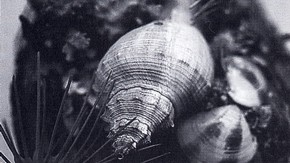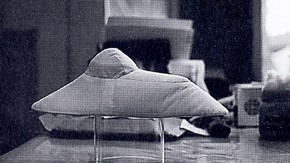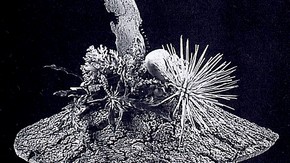Conservation Journal
January 1995 Issue 14
Ceremonial hat for eating Bouillabaisse: Eileen Agar 1936
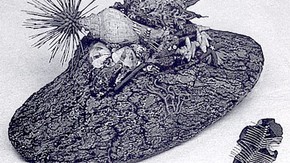
Fig. 1. Ceremonial Hat for Eating Bouillabaisse (before conservation), Eileen Agar, 1936. Museum no. T.168-1993 (click image for larger version)
One of the most unusual objects to come to the Textiles Conservation Section for treatment was acquired by the Museum in 1993. It is described as a 'Ceremonial Hat for Eating Bouillabaisse' and was made by the British surrealist artist Eileen Agar in 1936. (Fig.1)
Eileen Agar achieved overnight success after the first International Surrealist Exhibition in London at the New Burlington Galleries in 1936. She had studied at the Slade, worked in England and in France and was part of the artistic circle which included Paul Nash, Man Ray, Pablo Picasso, Henry Moore and many others.
The provenance of the hat is well known. It was photographed being worn by Eileen Agar when she was an elderly woman, and had been kept in the possession of the artist until her death. The object was an important acquisition for the Museum as a piece of surrealist art. More importantly, within the history of dress and as an addition to the Museum's Dress Collection, it is a rare example of a surrealist-inspired fashion object. As such, it ranks alongside examples of work by Schiaparelli and Salvador Dali which are also held in the V&A Textiles and Dress Collection.
The hat is constructed on a cork bark base painted in blue and yellow and decorated with a large orange coloured plastic flower, a blue plastic star, assorted shells, two varieties of coral painted in green and pink, two star fish, twists of paper, a large glass bead, a piece of jigsaw puzzle, a piece of bark from a plane tree and a large fish bone.
Condition
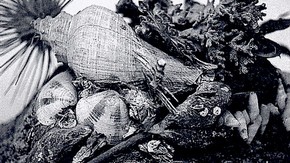
Fig. 2. Detail showing a variety of marine elements and the broken end of the fish bone (click image for larger version)
Overall, the condition of the object was good. Most of the pieces decorating the hat were sound and, although the bark and fish bone were detached, they were present and still joined to one another (Fig.2). It would later be possible to reattach them to the hat during the process of conservation. The fish bone showed evidence of three previous repairs indicating its extreme fragility. It looked as if it had originally been lifted from a cooked fish, then just dried and stuck onto the hat. It had very little strength and only the dried organic material around the vertebrae appeared to be holding it together. When mounted on the hat, the bone was supported by the plane bark onto which it had been glued.
The cork bark was structurally sound except for a few fragments that had come loose from the surface. These had also been kept and were available for reattachment. However, the hat was dirty. It was covered with a fine layer of dust, sooty in nature and greasy. There were also some dried-out flower petals caught between the shells and some fine wood shavings that may have been used for packing the hat at some time. The surface dust was visually disfiguring and served to mask the true colours of the hat and decorative elements upon it. It was known that the hat had been on open display in the artist's home for some considerable time.
Various elements of the hat were fragile, particularly the corals, which were brittle. The bark and fish bone were also both extremely vulnerable. One coral had evidence of recent damage. There was a clean exposed area on one of the branches where it had fractured. The broken off part was not included with the other detached fragments and was presumed to be lost.
There was evidence of adhesive deposits at several places on the hat suggesting that other elements may have been present at some time and that possibly alterations had been made to the original configuration of the decorative elements. Illustrations of two other similar hats included in the artist's autobiography confirmed that this was one of at least three versions made by the artist at different times. One photograph taken in 1936 shows the artist wearing what was probably the original version; another photograph shows a version that was featured on a television programme about hats in 1948. It was described by the artist as 'having been made a few years before... and consisted of a cork basket picked up in St Tropez and painted blue, which I covered with fishnet, a lobster's tail, starfish and other marine objects' 1 .The photographs are in black and white and unfortunately do not clearly show in detail all the decorative elements present. However, neither of these hats included the large plastic flower nor appeared to include the corals, bark and fish bone which are present on the recently acquired version. The V&A hat could have been a later and further adaptation of the original. It is possible that the hat was modified and changed over the years as bits fell off and as the artist found new elements that appealed to her.
Technical examination
Before treatment, the hat was documented and photographed. Various methods of technical examination and analysis were then used to identify some of the materials and components involved. For example, minute samples of the yellow and blue pigments were collected for microscopic and energy dispersive x-ray fluorescence spectroscopic (EDXRF) analysis from among the loose fragments. The yellow pigment was identified as chrome yellow. The blue was compared with Monastral, manganese, Irgalite and Vulcaflor blues but did not seem to be any of these. Nor was it Prussian blue. It appeared to be a mixture of an organic blue and yellow. The EDXRF analysis tended to confirm this suspicion. No elements were present other than chlorine. The blue pigment, therefore, was not firmly identified.
It was conjectured that the chlorine present in both pigments could have been a contamination absorbed from the cork bark. If the cork had been in the sea for some time, even though it is not an absorbent material, it would have been impregnated with a quantity of sea salt: sodium chloride. This would account for the presence of chlorine shown in the EDXRF spectra.
To identify the synthetic materials, minute samples were taken from the plastic flower and the blue plastic star. (The star was thought to be part of a Christmas tree decoration and similar ones were remembered by a number of people from their own childhood days in the 1950s). The samples were taken from inconspicuous places by gently rubbing with a silicon carbide paper and the analysis was carried out using Fourier transform infra-red spectroscopy (FTIR). The material used to make the flower was identified as polyvinyl chloride (PVC) which is known to have been produced from as early as 1927. The analysis of the material used to make the blue star suggested a copolymer of the type acrylonitrile/ butadiene/styrene (ABS) which was not commercially produced until the early 1950s. This strongly suggested that the star was a later addition to the hat and not part of the original applied elements.
Colleagues in the invertebrate department of the Natural History Museum were contacted to identify the marine life used to decorate the hat and to give an idea of where some of these may have been collected. It was known that Eileen Agar visited the south of France and other areas along the Mediterranean coast and also that the cork had been picked up in St Tropez. It was thought that some of the marine life may also have been of Mediterranean origin. It was not possible to identify all the species of marine life found on the hat, but listed below are those that could be named. Where possible, their geographical distribution is given, showing that some of them were likely to have been collected in the south of France along the Mediterranean coastline.
Mytilus edulis (edible mussel), worldwide distribution
Neptunea despecta (Neptune's whelk), Arctic seas
Callista cf chione (smooth callista), English Channel to Mediterranean
Cerithium vulgatum (common cerith), Mediterranean
Venerupis pullastra (carpet shell), Norway to North Africa
Asterias sp.(red starfish)
Ophioderma sp. (brittle star).
The fish bone was identified as from Solea solea, the common sole found around the British and Norwegian coasts and in the Mediterranean. Quercus suber (the cork oak) is also a native tree of the Mediterranean region. Platanus hybrida (the London plane) is a garden hybrid. It is not found in the wild but is grown throughout Europe. However, it is said not to fare well in the extreme north or south 2 . The piece of plane tree bark used on the hat to support the fish bone may therefore not have been collected in the South of France and would seem from the evidence already discussed not to be part of the original form of the hat.
Treatment
The dried flower petals and wood shavings were picked from the hat with fine pointed tweezers. Loose fragments of bark that had not fallen away were also picked off and put aside for reattachment after the hat had been cleaned. All the applied shells and other decorative elements were tested to make sure that they were still securely attached to the hat and all the adhesive bonds at the mounting points were still sound. The elements that were loose were noted for attention after cleaning had been completed.
The surface of the cork bark and all the decorative elements were vacuumed to remove surface dust. Particular attention was given to the crevices in the cork bark and the textured surface of the corals where a great deal of dust had become trapped. Minute cotton wool swabs moistened using a mixture of deionised water, IMS and a few drops of Synperonic detergent were then used to lift off the more stubborn greasy soiling. Detergent residue was removed using swabs moistened with deionised water alone. At no time were the painted surface of the bark or the water sensitive elements allowed to become wet (Fig.3). The locations for the detached pieces of cork bark were identified by close examination of the hat and these were re-attached using Mowilith DMC2 poly (vinyl acetate) emulsion.
The glue deposits and bark fragments marking previous attachment points of the plane tree bark and fish bone led to some confusion. It was clear that the bark had been positioned and glued on more than once, and the bark and bone would not now align exactly to any of these previous positions without twisting the fragile fish bone slightly and putting it under stress. It was decided to compromise and re-fix the bark as closely as possible to the attachment points to which it aligned most comfortably when allowing the fish bone to be rejoined exactly at the correct point without twisting. The safety of the fragile fish bone and a true realignment of the vertebrae were of primary importance and by making this compromise the fish bone could be correctly rejoined and both the bark and fish bone could be satisfactorily refixed to the hat.
The fish bone could not be repaired by splinting or by drilling and dowelling so the break was butt joined and held using Mowilith 50 poly (vinyl acetate) resin in acetone. It was necessary to support the bone while the adhesive dried so this was done with support cushions made of bubble wrap. A piece of coral and a shell that were found to be loose during the cleaning were also re-adhered in place using Mowilith 50 in acetone.
It was decided that the hat should go on display as soon as possible so a support stand was constructed on which the hat could be both displayed and stored when necessary. Because of its fragility, it was essential that the hat itself should not be touched when moved. The stand was therefore made so that it could be used for handling. It was fashioned using card, polyester wadding as cushioning, cotton lawn and perspex according to a long established method devised in the Conservation Department some years ago for the general support and care of hats 3 (Figs.4,5).
Acknowledgements
I would like to acknowledge and thank Amy de la Haye of the Textiles and Dress Collection for background information on Eileen Agar, Josephine Darrah for carrying out the EDXRF and pigment analysis, Brenda Keneghan for carrying out the FTIR spectroscopy and identifying the plastics, and Kathie Way and Oliver Crimmen of the Natural History Museum for identifying the marine life.
Materials
The production of Mowilith 50 DM C2 has ceased
Mowilith 50
IMS (industrial methylated spirits)
Synperonic detergent
References
1.Agar, E., A Look at my Life, Methuen, London, 1988
2.Polunin, O. and Everard, B., Trees and Bushes of Europe, Oxford University Press, London, pp. 53, 71,189,190
3.Kite, M., The Conservation of Three Straw Hats, The Conservator, No.15,1991, pp. 7-12
January 1995 Issue 14
- Editorial
- Ceremonial hat for eating Bouillabaisse: Eileen Agar 1936
- Measuring pollution in the museum environment
- The tail of the tiger: conservation of a pichhwai fragment
- The role of the 'barefoot' conservator
- Review: polymers in museums
- Review: 'New Horizons': the designer bookbinders' conference
- Review: the annual conference of the association for historical and fine art photographers
- RCA/ V&A new students for the academic year 1994/95
